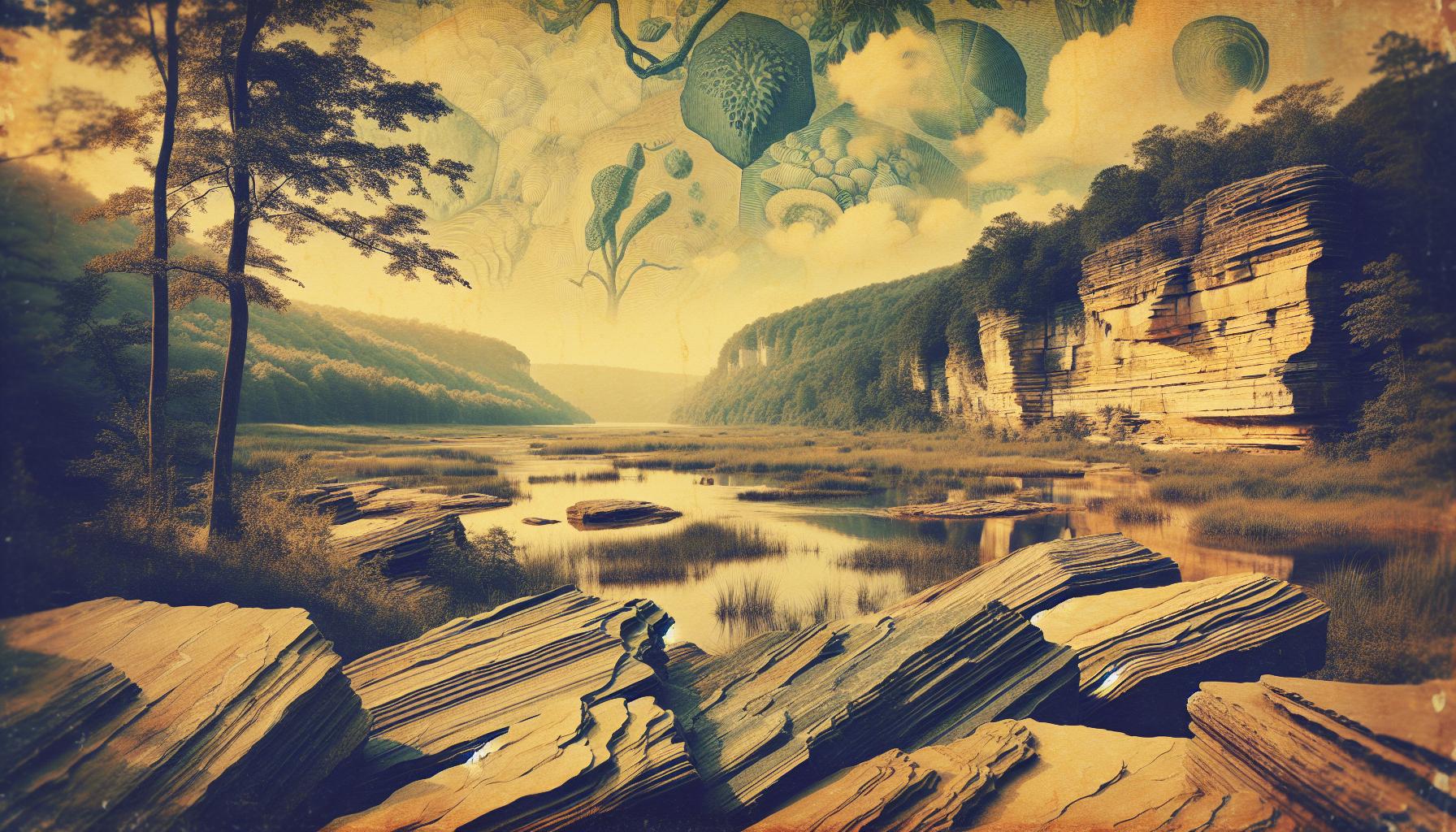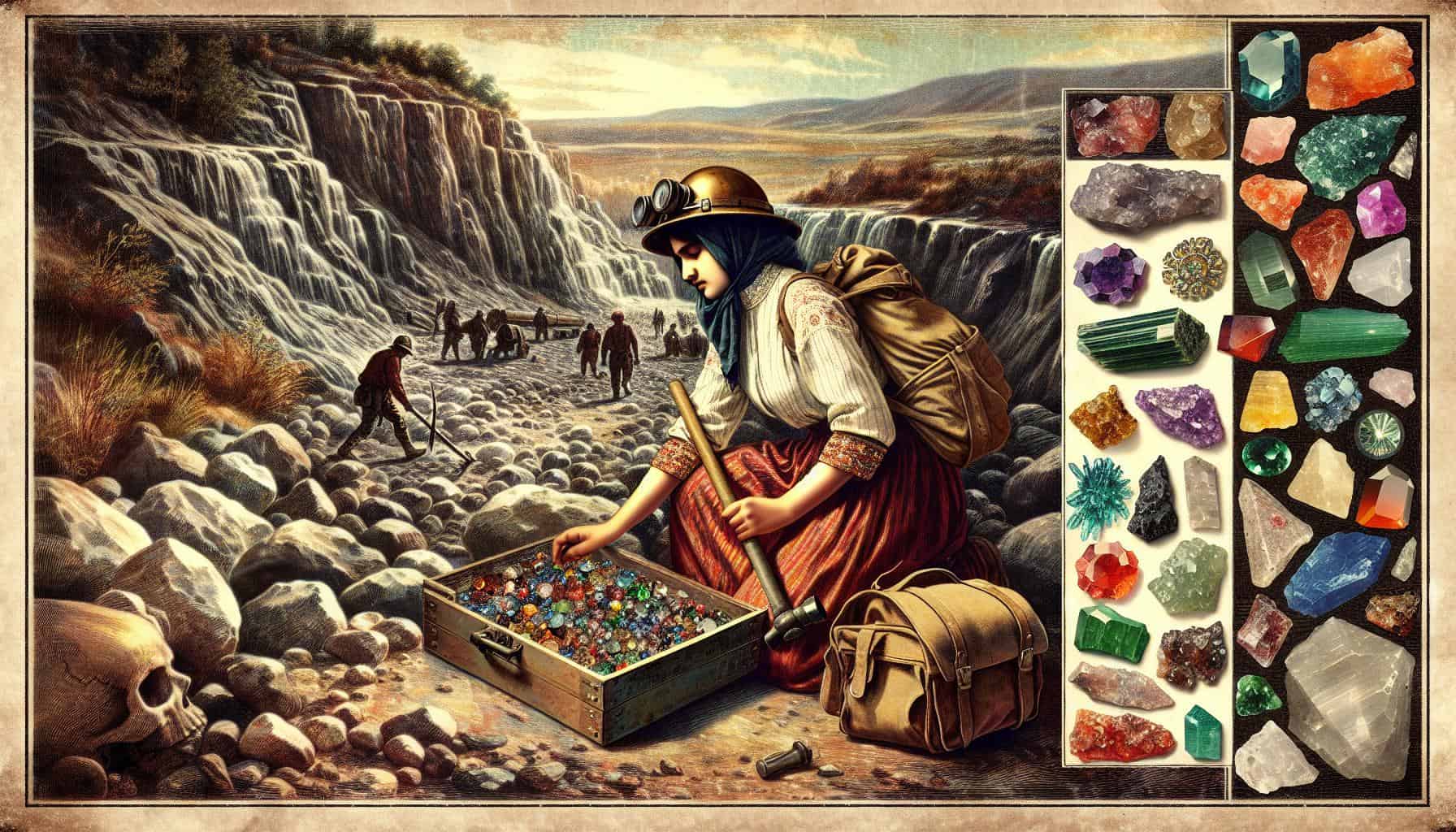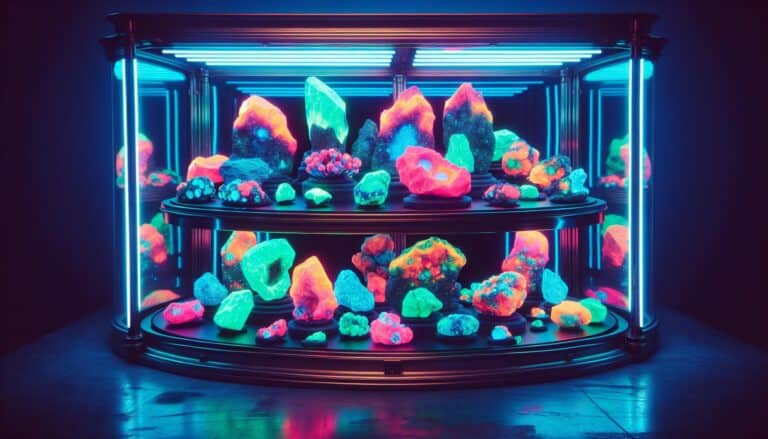You’re about to embark on a treasure hunt across Maryland, a hidden gem for rockhounds.
With its diverse geological landscapes, you’re in for a real treat. From the ancient mountains of the west to the serene shores of the Chesapeake, Maryland’s got a surprise waiting for every enthusiast.
Whether you’re a seasoned rockhound or just starting, you’ll find something special here. Quartz, fossils, or even gold—you never know what’s beneath your feet.
Let’s dig into the best spots for rockhounding in Maryland and what incredible finds you might unearth.
Unearth Maryland’s treasures: Potomac quartz, Calvert shark teeth, and hidden gems like amethyst await, responsibly explore with permission and proper gear!
Maryland Rockhounding Locations
When you’re planning your next rockhounding adventure in Maryland, you’ll be delighted by the number of locations available to explore. From the bustling beaches to the quiet mountainsides, there’s a spot for every type of collector.
Potomac River Sites
The historical Potomac River offers ample chances for rockhounds to scoop up Quartz Crystals and Shark Teeth. Areas around the towns of Potomac and Hancock have become popular for their ease of access and picturesque views, which serve as a bonus to the rockhounding experience. Be sure to check local regulations before you start your search as some areas may require permits.
Calvert Cliffs State Park
Arguably the most famous spot is Calvert Cliffs State Park, located along the Chesapeake Bay. The majestic cliffs have eroded over time, providing an abundance of Miocene Fossils which include shells, whale bones, and the highly sought-after shark teeth. Take a hike down the scenic trails before arriving at the beach where the real treasure-hunting begins.
Patapsco Valley State Park
Patapsco Valley State Park, with its diverse landscape, is a treasure trove for rock collectors. As you hike along the riverbanks and streams, keep your eyes peeled for Serpentine and Soapstone. The park’s vast area means that it’s less likely to be picked over than more well-known locations.
Still Pond
For a quieter experience, Still Pond can be your go-to destination. This area is recognized for its deposits of Quartz and its variety of Minerals. It’s an excellent place for a peaceful day out, scanning the soil for hidden gems.
You’ll find that each location in Maryland offers a unique rockhounding experience, with an array of different minerals and fossils just waiting to be discovered. Pack your gear, grab a map, and immerse yourself in the hunt for geological wonders. Remember, the adventure lies as much in the search as it does in the find. Keep your eyes open, and you’ll unearth more than just rocks – you’ll discover the rich tapestry of Maryland’s geological history.
What Gemstones are Found in Maryland?

As you continue to explore Maryland’s rich geological landscape, you’ll find that gemstones add a sprinkle of color to your rockhounding adventures. Maryland is known for several precious and semi-precious stones, offering a variety of collecting experiences for both novice and seasoned enthusiasts.
Patuxent River area, for instance, is a hotspot for finding agate. Agate here comes in unique bands of color, making each piece a one-of-a-kind find. These stones are not only beautiful but also serve as excellent material for jewelry and ornamentation due to their durability.
Beyond agates, the regions around central Maryland are favorable for unearthing garnets. Garnets range in color from deep red to vibrant green and have a history of being treasured for their beauty and supposed metaphysical properties. They’re typically seen in sedimentary rocks such as schist and gneiss.
Table: Noteworthy Gemstones in Maryland
| Gemstone | Location | Color | Notes |
|---|---|---|---|
| Agate | Patuxent River | Varied | Used in jewelry |
| Garnet | Central Maryland | Red to Green | Found in schist and gneiss |
| Amethyst | Patapsco Valley | Purple | Quartz variety |
| Jasper | Coastal Plain | Red, Brown | Formed from volcanic ash |
For the amethyst seekers, Patapsco Valley may be the place to be. Although rarer than quartz, catching that purple glint amongst riverbeds can be very rewarding. It’s important to note that while amethyst is a variety of quartz, its violet shimmer sets it apart.
Jasper can also be discovered, especially in the Coastal Plain region. This gemstone is often red or brown and formed from volcanic ash, giving each piece a certain character that is well-sought after by collectors.
Remember to equip yourself with proper rockhounding tools and always seek permission where necessary before embarking on your quests. Also, familiarize yourself with Maryland’s gemstone identification guides to make sure you recognize your finds and understand their value. Each gemstone found adds to the exciting collecting journey across Maryland’s diverse landscapes.
What Sedimentary Rocks You Can Find in Maryland?

Venturing through Maryland on your rockhounding quest, you’ll also uncover a variety of sedimentary rocks, each with its own fascinating history and formation process. The Potomac River basin is a haven for sedimentary rock enthusiasts. Here, you can find sandstone and shale, two rocks that tell ancient stories of rivers and seas from millions of years ago.
Sandstone is prevalent along the river cliffs and outcrops, often revealing itself in shades of tan and yellow. It’s formed from compacted sand over time, with each grain potentially originating from distant mountains and ancient landscapes. On the other hand, shale, recognized by its fine layers that split easily into fragile sheets, is also abundant in the area. Shale’s delicate composition suggests that it was formed in calm waters, likely an ancient seabed.
Additionally, Maryland’s Piedmont region holds a treasure trove of limestone, a rock highly sought after for its fossil content. It’s not uncommon to find specimens bearing the imprints of marine life from when the area was submerged under a warm, shallow ocean. Limestone can appear in a variety of colors, often forming near mineral springs and in environments where marine creatures flourish.
Prepare to also encounter siltstone, a close cousin to shale and sandstone but with a much finer quality. While it resembles shale in texture, it’s more durable and typically lighter in color. The presence of siltstone is a clue to a past where rivers were slower, depositing fine particles over centuries, creating the rock layers you find today.
Remember, when you’re on the hunt for these sedimentary marvels, to bring a rock hammer, chisel, and protective eyewear. Properly identifying and extracting these rocks requires patience and a delicate touch, as they can be quite fragile compared to their igneous and metamorphic counterparts. Whether you’re exploring coastal cliffs or the rolling hills of central Maryland, the sedimentary rocks you encounter will add depth and history to your collection.
What Metamorphic Rocks are found in Maryland?
When seeking out the hidden treasures that lie beneath Maryland’s surface, you’ll discover that the state’s geological history has blessed rockhounds with an array of metamorphic rocks. These rocks have undergone transformation through intense heat and pressure—a testament to the dynamic processes of the Earth.
Schist and gneiss are among Maryland’s most common metamorphic rocks. You might find them primarily in the Piedmont region, where the earth’s movements from eons ago have left behind a rich tapestry of minerals. Schist, with its well-developed layered appearance, often contains flakes of mica that can catch the sun and sparkle brilliantly. Gneiss, notable for its bands of light and dark minerals, reveals the history of its formation through its ribbon-like layers.
Exploring Maryland’s metamorphic offerings, you’ll also find slate, which has been used historically for everything from roof shingles to sidewalk slabs. It’s known for its fine grain and durability. Here’s a quick rundown of where to find these rocks:
- Schist: Potomac Highlands, Baltimore area
- Gneiss: Central Piedmont region
- Slate: Appalachian Plateau, particularly in the western parts of Maryland
It’s important to remember that identifying metamorphic rocks requires a keen eye for detail, as the intricate patterns and variations in composition can be subtle. Proper tools like a geologist’s hammer and hand lens are not only helpful; they are indispensable for accurately identifying and collecting specimens.
Those fascinated by the transformation of rocks won’t want to miss the opportunity to explore Maryland’s state parks. Patapsco Valley State Park and Sugarloaf Mountain are places where amateur geologists can marvel at the complexity and beauty of Maryland’s metamorphic rocks. Remember that while removing rocks from state parks is prohibited, you can still enjoy the thrill of discovery and observation.
As you’re out and about searching for these geologic wonders, always practice Leave No Trace principles. This ensures that sites remain undisturbed and protected for future explorers and maintains the natural beauty for everyone to enjoy.
What Igneous Rocks can You Find in Maryland?
When you’re on the hunt for igneous rocks in Maryland, you’re in for a real treat. These rocks form from the cooling and solidification of magma or lava, and Maryland offers a variety of locations where these geological wonders can be uncovered. Most notably, basalt and granite are the primary igneous rocks you might come across.
Starting with basalt, this dense volcanic rock is typically fine-grained and dark in color. You’ll find basalt primarily in the Piedmont region where ancient lava flows once existed. These areas now provide an excellent opportunity for rockhounders to add a piece of volcanic history to their collections.
In contrast, granite presents with a coarse-grained texture and is often speckled with a mosaic of quartz, feldspar, and mica. It’s not just a pretty rock; it’s also a testament to Maryland’s geologic diversity. Granite quarries, such as the Woodstock Quarry in Baltimore County, can be fruitful locales for those wanting to take a piece of Maryland’s igneous formations home. Don’t forget to seek permission where necessary before you start chiseling away at these historical sites.
For those specifically interested in pegmatite, a type of intrusive igneous rock known for its large crystals, you’re in luck. Areas around Cecil County are known for these intriguing formations. Gem-quality minerals, such as beryl and tourmaline, have been discovered within these rocks, making them particularly exciting for mineral enthusiasts.
Remember, while Maryland’s igneous rocks tell a story millions of years in the making, they also require respect and care during collection. Carry the right tools and always adhere to the ethical guidelines of rock collecting. This will ensure these treasures continue to be available for generations of rockhounders to come.
Exploring Maryland’s igneous rock locations isn’t just about adding to your collection; it’s an adventure into the past. As you unveil layers of Earth’s history, take time to appreciate the processes that shaped the terrain you walk upon.
Panning for Gold in Maryland
If you’re captivated by the allure of discovering gold, Maryland offers some historic streams where you can pan for this precious metal. Though not as widely known as the Gold Rush territories of the West, Maryland’s Gold Belt, a region that runs through the center of the state, provides modest opportunities for panners and prospectors.
Popular spots along the Potomac River have caught the attention of gold seekers since the early 1900s. Great Falls and Olmsted Island are two such areas where people have reported success. Remember, permission is essential if you’re venturing onto private land and local regulations regarding mineral collection must be observed.
Here’s what you might expect when panning in Maryland:
- Flour gold: Fine particles of gold, resembling flour in texture.
- Small nuggets: Rare, but the thrill of finding one is unparalleled.
Equipment you’ll need includes a gold pan, classifier, and a shovel or scoop. A sluice box can increase your chances of success but it’s also heavier and requires more setup time. You’ll want to wear sturdy boots and bring along insect repellent during the warmer months to deal with Maryland’s robust mosquito population.
Maryland gold is typically found in the form of very fine particles—often no larger than small grains of sand. They tend to settle at the bottom of streams, so you’ll need patience and a keen eye to spot the glimmer of gold against the earthy streambed. It’s also worth keeping an eye out for other minerals, such as quartz and mica, which sometimes accompany gold in this region.
As with all forms of rockhounding, the key is to enjoy the activity while preserving nature. Leave no trace of your visit behind and respect the environment as you search for that elusive sparkle. It’s not just about what you find, but the experience of being in the great outdoors, exploring Maryland’s landscapes with the added excitement of perhaps striking gold.
Rocks and Minerals Found in Maryland
As you explore Maryland’s diverse geology, you’ll uncover a spectrum of minerals and rocks that are as rich in history as they are in variety. Quartz, for instance, is abundantly found throughout the state. Its numerous forms, including clear, milky, smoky, and amethyst, allure both novice and seasoned collectors.
In particular, the Serpenitinite belt, stretching through the state, is a hotspot for chromium minerals. Here, you might stumble upon small but significant pieces of this valuable ore. Garnets, characterized by their deep red hue, are also present, mainly in the Piedmont and Appalachian regions. These treasures, often hidden in mica schist, can be a thrilling find for anyone fascinated by Maryland’s natural wonders.
Venturing into the western part of Maryland, you’ll discover the Bare Hills, where former quarries offer up specimens of serpentine and soapstone. These sites are worth a visit for their historical significance and potential finds. If you’re keen on fossils, Calvert Cliffs along the Chesapeake Bay is a renowned locale where Miocene-era shark teeth and other marine fossils are frequently found washed ashore.
| Mineral | Areas Commonly Found |
|---|---|
| Quartz | Statewide |
| Chromium Minerals | Serpenitinite Belt |
| Garnets | Piedmont, Appalachian Range |
| Serpentine | Bare Hills |
| Soapstone | Bare Hills |
| Fossils | Calvert Cliffs |
It’s crucial to bear in mind that rockhounding in Maryland requires adherence to the law and respect for private property. Always seek permission before exploring private lands and adhere to regulations in protected areas. Above all, ensure you leave no trace, preserving these remarkable landscapes for future generations to explore and enjoy.
Where Can I Find Fossils in Maryland?
Maryland’s rich geological history offers plentiful opportunities for fossil enthusiasts. When looking for prime fossil locations, start with Calvert Cliffs State Park. Ancient shark teeth, whale bones, and shell fragments are part of the myriad fossils embedded in the cliffs, dating back to the Miocene Epoch.
If your interests lie in finding remnants of prehistoric creatures, Purse State Park – also known as Nanjemoy Wildlife Management Area – proves to be a treasure trove. Located on the Potomac River, this site yields a variety of fossils including shark teeth, fossilized ray plates, and even the occasional, rare dugong rib.
Flag Ponds Nature Park should not be overlooked by any serious fossil hunter. Beyond just the allure of scenic views, the park’s shores have relinquished numerous ice-age fossils. In the warmer months, sift through the sand and tide line to discover fragments of Maryland’s ancient nautical past.
Remember, while you’re on the hunt, it’s essential you’re aware of property boundaries and regulations, as many fossil-rich sites are protected areas.
For those who might want to wander off the beaten path, consider the Matoaka Beach Cabins in St. Leonard. A private beach famous for its peaceful solitude also allows for fossil collecting for a nominal fee. This site’s highlights are the well-preserved shells and sharks’ teeth that wash ashore.
In western Maryland, fossils can also be found in sedimentary rock formations. Hyattstown Mill is known for plant impressions and smaller fossils, a sign of the region’s ancient climate and biodiversity that prevailed long before human history began to unfold.
By taking the time to explore these sites, you’ll not only gain a tangible piece of the past but also an invaluable understanding of the earth’s evolutionary tale. Keep in mind, research and preparation are crucial for a successful rockhounding expedition. Maps, tools, and proper permits can make all the difference in what you’ll uncover.
Maryland Rockhounding Laws & Regulations
While you’re exploring Maryland’s diverse rockhounding sites, it’s critical to stay informed about local laws and regulations. Maryland Department of Natural Resources (DNR) oversees most of the policies that affect collecting in state parks and public lands.
First and foremost, always obtain permission when you’re on private land. Trespassing to hunt for rocks and minerals is illegal and could land you in trouble. On public lands, the rules can vary:
- Fossil Collecting is often allowed, but there may be limits on the quantity and type of fossils you can take.
- Commercial collecting, selling, or trading of any natural material from public lands is strictly prohibited.
- Metal Detectors are typically not allowed in state parks without a permit.
At state parks such as Calvert Cliffs, Purse, and Flag Ponds, you’re allowed to collect fossils for personal use, but remember the daily bag limits. State parks generally allow you to gather reasonable amounts of minerals and gemstones for personal collections; however, fossil collecting is subject to stricter scrutiny to avoid damaging important paleontological sites.
The Maryland Park Service has clear guidelines to ensure conservation:
- Don’t use tools that can harm the environment, such as shovels or pickaxes.
- Leave no trace – fill in any holes you dig and take your trash with you.
- Respect wildlife and their habitats.
Be sure to check with the local park office or the DNR website before planning your trip, as regulations can change. They might have specific information about the area you’re interested in, including any restrictions or permits required. By following these rules, you’ll help preserve Maryland’s geological wonders for future generations of rockhounds.
Rockhounding Tips for Beginners in Maryland
When you’re starting out on your rockhounding journey in Maryland, it’s imperative to know the basics. From the tools needed to ensure an effective hunt to the safety and legal guidelines to abide by, this section offers valuable insight.
Gearing Up: Essential Tools for Rockhounding
Rockhounding isn’t just about finding the best spots; it’s also about having the right tools for the job. Here are the essentials you’ll need:
- Rock Hammer: A sturdy hammer is crucial for chipping away at rocks and extricating the gems.
- Chisels and Picks: These sharp tools help you carefully extract specimens without causing damage.
- Safety Glasses: To protect your eyes from flying debris.
- Gloves: Durable gloves safeguard your hands from sharp edges and rough surfaces.
- Backpack: A strong backpack to carry your tools and findings.
- Sturdy Footwear: Reliable boots to navigate tough terrain safely.
- First Aid Kit: For those unexpected scrapes or bruises along the way.
Remember, quality equipment can make or break your rockhounding experience. Select gear that’s both durable and appropriate for the terrain you’ll be exploring.
Safety Tips While Rockhounding
Your safety should always be a top priority while rockhounding. Keep these tips in mind to ensure a safe outing:
- Stay Hydrated: Carry enough water, especially during hot Maryland summers.
- Be Weather Aware: Check the forecast and dress appropriately; have a plan for sudden weather changes.
- Know Your Limits: Don’t overextend yourself; be mindful of your physical abilities.
- Buddy System: Whenever possible, go with a friend or let someone know your plans.
- Cell Phone: Ensure it’s fully charged for emergencies.
- Watch Your Step: Be cautious of unstable terrain and potential wildlife.
By staying prepared, you’re more likely to have an enjoyable and injury-free rockhounding trip.
Legal Guidelines for Rockhounding Enthusiasts
Navigating the legal landscape is essential for responsible rockhounding. Here’s what you need to know:
- Permission: Always seek permission before entering private land.
- State Laws: Familiarize yourself with Maryland’s laws regarding rockhounding on public land, available on the DNR website.
- No-go Zones: Some areas are protected and cannot be accessed for rockhounding.
- Collection Limits: Be aware of any restrictions on the amount of material you can collect.
- Respect Nature: Leave the site as you found it for others to enjoy.
Abiding by these rules not only keeps you out of trouble but also helps protect Maryland’s natural resources.
Conclusion: Maryland Rockhounding Map
Venturing into Maryland’s diverse landscapes offers a unique opportunity to add some impressive specimens to your collection.
Whether you’re scouring the beaches for fossilized shark teeth or exploring the mountainous regions for quartz crystals, you’ll find that each location presents its own set of treasures. Remember to equip yourself with the right tools and knowledge to make your rockhounding adventure as rewarding as it is exciting. Stay safe, respect the legalities, and preserve the natural beauty of the sites you visit. With these practices in place, you’re all set to enjoy the thrill of the hunt and the joy of discovery that rockhounding in Maryland has to offer.
Happy rockhounding!







